Travelling with our beloved canine companions is one of life’s great pleasures, whether it’s a short trip to the park or a grand cross-country adventure. However, ensuring their safety and the safety of everyone else in the vehicle is paramount. While comfort, convenience, and durability are all crucial factors when choosing a dog car seat belt or harness, the ultimate goal is peace of mind, knowing your dog is secure. For dog owners in the UK, selecting the Best Dog Car Seat Belt Uk means navigating various options to find a restraint that meets both safety standards and practical needs.
This comprehensive guide from Dog Care Story delves into the importance of properly restraining your dog in the car, explores current safety standards, and reviews top-rated dog car seat belts and harnesses available in the UK, helping you make an informed decision for your pet’s next journey.
 Brindle dog secured in a crash-tested car seat belt harness in the UK
Brindle dog secured in a crash-tested car seat belt harness in the UK
Why a Dog Car Seat Belt is Essential in the UK
The importance of using a dog car seat belt or harness extends far beyond just protecting your furry friend. It’s a critical safety measure for all occupants of the vehicle and a legal requirement under the UK Highway Code.
Firstly, a suitable restraint can significantly protect your pet from injury during sudden stops, swerves, or collisions. An unrestrained dog can be thrown around the vehicle, sustaining serious injuries or even worse. Imagine that in a 50mph collision, an unrestrained 10-pound pet transforms into a projectile exerting 500 pounds of force. For a 60-pound dog, that’s a staggering 3,000 pounds of force! This immense force poses a severe risk not only to the dog but also to human passengers in the car.
Secondly, a secure dog is a less distracting dog. An excited, nervous, or playful pet can easily divert a driver’s attention, leading to dangerous situations or even causing an accident. Pets moving freely around the vehicle can block views, interfere with controls, or attempt to climb onto the driver’s lap. The best dog car seat belt UK will prevent such distractions, allowing you to focus on the road.
Moreover, the UK Highway Code (Rule 57) states: “When in a vehicle make sure dogs or other animals are suitably restrained so they cannot distract you while you are driving or injure you, or themselves, if you stop quickly. A seat belt harness, pet carrier, dog cage or guard are ways of restraining animals in cars.” Failure to comply with this rule could lead to a fine, points on your license, or even prosecution in the event of an accident. Therefore, a reliable dog car seat belt is not just a recommendation; it’s a legal obligation for responsible pet owners. For more detailed insights, you might be interested in our guide on best dog seat belt harness uk.
Understanding Dog Car Restraint Standards and Laws in the UK
While the UK Highway Code clearly mandates that pets must be suitably restrained, specific crash-test standards for pet car harnesses are not yet legally enforced in the UK, similar to other regions. This lack of standardised regulation can make choosing a truly safe product challenging.
Historically, organisations like the Center for Pet Safety (CPS) in the US have conducted independent studies, revealing that many pet travel harnesses failed basic crash tests. While these tests are US-based, their findings highlight a universal concern: manufacturers’ claims of “crash-tested” don’t always guarantee safety without independent verification. The results of manufacturer-performed tests are not always disclosed, making it difficult for consumers to ascertain the actual level of protection offered.
Harness manufacturers can opt for independent testing and certification, such as by the CPS. While a US-based certification, it signifies a higher level of scrutiny and provides a strong indicator of a product’s safety performance, even for the UK market. We place greater emphasis on harnesses that have undergone such rigorous, third-party testing when considering the best dog car seat belt UK.
Therefore, when looking for a dog car seat belt in the UK, it’s crucial to seek out brands that demonstrate transparency in their testing methods and ideally have certifications from reputable independent bodies, regardless of their geographical origin. This approach helps ensure that the product you choose will genuinely protect your pet and comply with the spirit of the UK’s Highway Code.
How We Selected the Top Dog Car Seat Belts
With over 12 years of travelling full-time with our dogs and reviewing countless pet products, our team at Dog Care Story has developed a keen understanding of what makes a truly effective dog car seat belt. Our selection process for the best dog car seat belt UK is rooted in practical experience and a commitment to animal welfare.
We prioritise products designed with the same meticulous attention to detail you would expect for any human family member. Our evaluations go beyond marketing claims, focusing on real-world performance, durability, and user experience. Crucially, we also consider the dog’s perspective. Our beloved companion, Myles, has been instrumental in testing these harnesses. We observe how he reacts to each harness, judging:
- Fit: Does it provide a snug yet comfortable fit without restricting movement?
- Ease of Use: How straightforward is it to put on and take off, especially for everyday use?
- Comfort During Travel: How comfortable does Myles appear to be while wearing the harness during short and long car journeys?
This hands-on approach, combined with a deep understanding of safety principles and material quality, allows us to recommend dog car seat belts that we believe genuinely offer superior protection and comfort for your pet. For those with larger breeds, finding the right fit is especially critical, and we also have a dedicated guide on the best car seat belt for large dogs.
Top-Rated Dog Car Seat Belts for the UK Market
Dog Care Story received the products discussed below free of charge for review purposes. The opinions expressed here are our own and reflect our genuine experiences and assessments.
Dog Care Story may earn commission or revenue on some items through the links below.
BEST OVERALL
OptimusGear Defender Harness
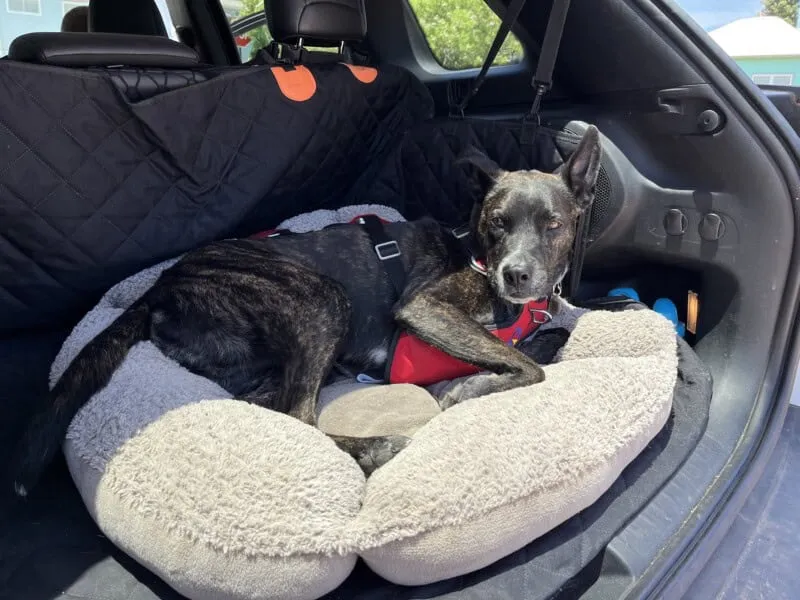 Myles, a brindle dog, wearing a large OptimusGear Defender car seat belt harness for UK travel
Myles, a brindle dog, wearing a large OptimusGear Defender car seat belt harness for UK travel
Highlights
- Crash-Tested: Uses Federal Motor Vehicle Safety Standard – FMVSS213, a stringent US standard.
- Sizes Available: S to XL.
- Weight Capacity: 25 to 75 pounds (approx. 11.3 kg to 34 kg).
- Installation: Connects to two LATCH anchors in your vehicle (or ISOFIX in the UK) with tethers, and a carabiner to the seatbelt. Tethers then connect to the harness.
The OptimusGear Defender Harness stands out as one of the most durably constructed dog car seat belts we’ve reviewed, making it a strong contender for the best dog car seat belt UK. It’s engineered to withstand significant impact forces, featuring stress-tested custom metal buckles and hardware, along with high-strength webbing. The padded chest and back panels not only provide excellent comfort for your dog but also distribute forces evenly in the event of a collision. Its dual leash attachment points (chest and back) also make it highly convenient for quick walks before or after a car journey.
What We Like:
- Exceptional design that gives dogs a ‘superhero’ look.
- Easy over-the-head style familiar to most dog owners.
- Robust, heavy-duty metal buckles that are simple to operate.
- Versatile leash attachments on both chest and back.
- Available in a selection of colours.
- Padded vest is easy to keep clean.
- Four adjustment points ensure a precise and secure fit for various body types.
What We’d Change:
- We honestly couldn’t find any significant drawbacks with this harness.
RUNNER UP
SleepyPod Clickit Sport Harness
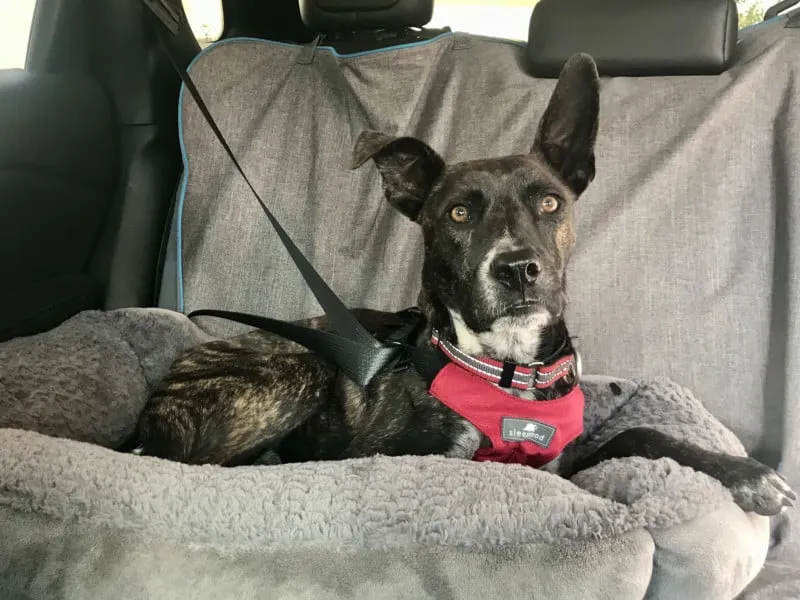 Brindle dog, Myles, securely buckled in a red Sleepypod Clickit Sport car seat belt harness, ideal for UK journeys
Brindle dog, Myles, securely buckled in a red Sleepypod Clickit Sport car seat belt harness, ideal for UK journeys
Highlights
- Crash-Tested and Certified: Verified by the Center for Pet Safety (CPS), offering a high level of independent assurance.
- Sizes Available: S to XL.
- Weight Capacity: 18 to 90 pounds (approx. 8.2 kg to 40.8 kg).
- Installation: The vehicle’s seat belt passes through two dedicated loops on the back of the harness.
The SleepyPod Clickit Sport Harness exemplifies thoughtful design and uses the highest quality materials, characteristic of all SleepyPod products. Its innovative Infinity Loop design, combined with a padded vest, seat belt grade straps, and stress-tested buckles, is specifically engineered to absorb and distribute damaging forces during a car collision. With three seat belt contact points, it provides outstanding security for your dog, making it a reliable option among dog car seat belts.
What We Like:
- Sleek and minimalist design, free from unnecessary bulk.
- Step-in style makes it remarkably easy to put on and take off.
- Convenient double D-rings on the back allow for easy leash attachment for short walks.
- Available in a range of colours.
- Constructed from durable ballistic nylon with a neoprene padded vest, making it simple to clean.
What We’d Change:
- The straps can be somewhat challenging to adjust.
- May not be an ideal fit for deep-chested breeds such as Greyhounds, Whippets, Salukis, Afghan Hounds, and Borzoi.
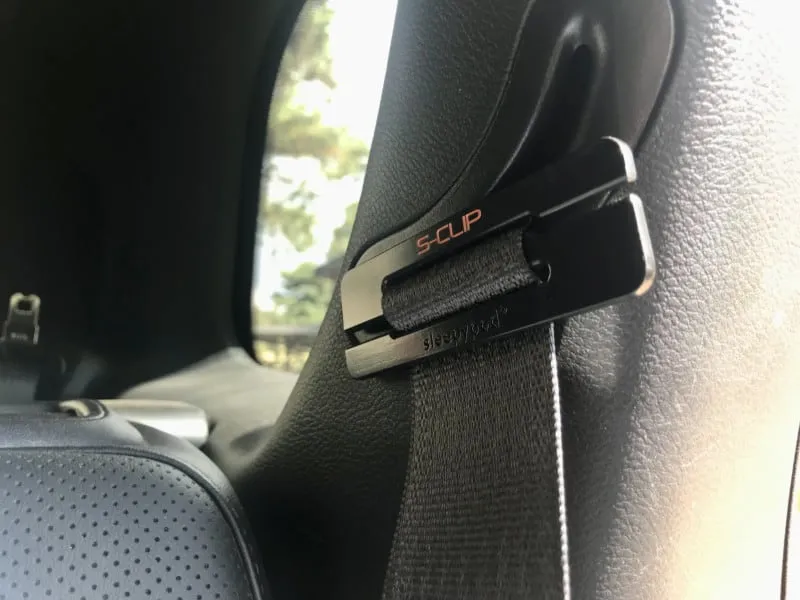 Sleepypod S-Clip accessory for securing a dog car seat belt in a UK vehicle
Sleepypod S-Clip accessory for securing a dog car seat belt in a UK vehicle
BEST FOR ESCAPE ARTISTS
Ruffwear Load Up Harness
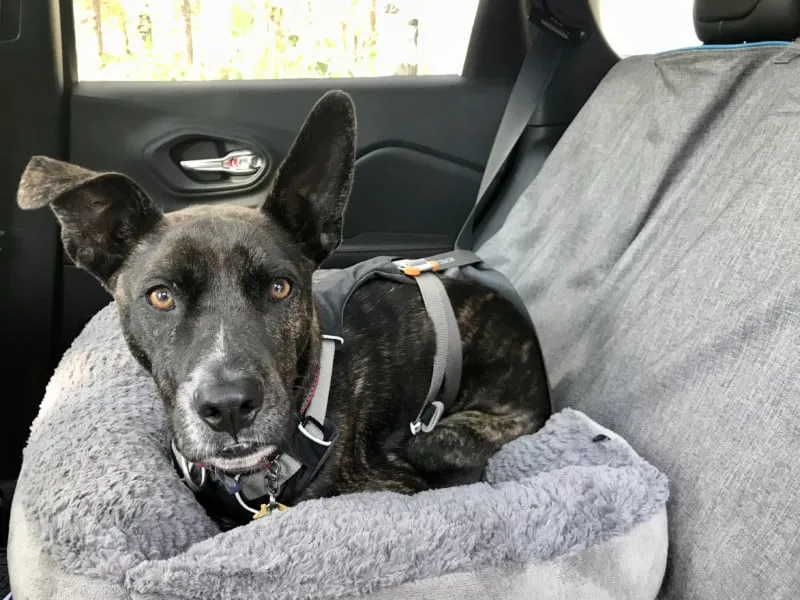 Brindle dog, Myles, securely buckled in a crash-tested Ruffwear Load Up car safety harness for UK travel
Brindle dog, Myles, securely buckled in a crash-tested Ruffwear Load Up car safety harness for UK travel
Highlights
- Crash Tested: Tested at a National Highway Traffic Safety Administration (NHTSA) contracted test facility for dogs up to 75 pounds (approx. 34 kg).
- Sizes Available: XXS to L/XL.
- Girth Capacity: 13 to 42 inches (approx. 33 cm to 106 cm).
- Installation: The vehicle’s seat belt passes through a single loop at the back of the harness.
The Ruffwear Load Up harness, like all Ruffwear gear, is built with adventure in mind and provides exceptional security for the more determined canine traveler. This harness has undergone dynamic crash testing and static tensile testing of all its critical components. Featuring all-metal hardware, a tough polyester shell, and a comfortable polyester lining, it boasts both strength and remarkable durability. The generously sized belly panel offers ample coverage, making it incredibly difficult for even the cleverest escape artists to wriggle free, solidifying its place as a robust choice for the best dog car seat belt UK.
What We Like:
- Extremely durable construction built to last.
- Conveniently hand washable for easy maintenance.
- Four adjustment points allow for a highly customised fit.
- Velcro tabs keep excess straps neatly secured.
- Designed to be comfortable for extended wear, ideal for long journeys.
What We’d Change:
- The large belly panel, while effective for security, can potentially make the harness hot for dogs in warmer weather or environments.
- Lacks D-rings for attaching a leash, meaning it’s primarily for car use and a separate walking harness is often needed.
MOST CONVENIENT
Kurgo Enhanced Strength Tru-Fit Harness
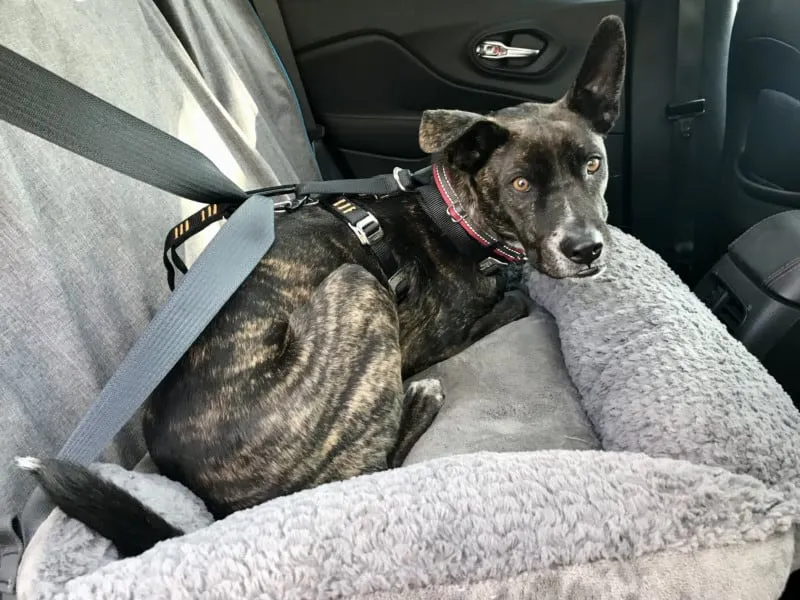 Myles, a brindle dog, safely secured in a medium Kurgo Enhanced Strength Tru-Fit car seat belt harness, perfect for UK roads
Myles, a brindle dog, safely secured in a medium Kurgo Enhanced Strength Tru-Fit car seat belt harness, perfect for UK roads
Highlights
- Crash Tested: Evaluated at a university testing facility for dogs up to 75 pounds (approx. 34 kg) at 30 miles per hour (approx. 48 km/h).
- Sizes Available: XS to XL.
- Weight Capacity: 5 to 105 pounds (approx. 2.3 kg to 47.6 kg).
- Installation: Utilises an included carabiner to attach the harness straps directly to the vehicle’s seat belt.
Kurgo’s Enhanced Strength Tru-Fit harness was crash-tested at a facility adhering to Federal Motor Vehicle Safety Standard No. 213 for Child Restraint Systems, giving pet owners confidence in its safety performance. It features robust all-steel hardware for superior strength and longevity. Equipped with both front and back D-ring leash attachments, it doubles efficiently as a walking harness. This harness truly shines in its convenience; the seat belt can remain buckled with the carabiner attached, allowing for quick release of the harness straps when your dog needs to exit the car, streamlining every journey. It’s a top choice when considering the best dog car seat belt UK for ease of use.
What We Like:
- Simple, non-bulky design.
- Traditional over-the-head style familiar to most dog owners.
- Front and back D-rings make it excellent for everyday walks.
- Five adjustment points ensure an optimal and secure fit.
- Machine washable for effortless cleaning.
- Comes with an all-steel carabiner, simplifying the buckling process.
What We’d Change:
- Some users find the nesting buckles challenging to operate.
- On certain deep-chested breeds, the straps might cause chafing behind the front legs, which is a common issue with some dog car harnesses.
MOST VERSATILE
Sleepypod Clickit Terrain Harness
 Brindle dog, Myles, securely buckled in a crash-tested Sleepypod Clickit Terrain dog harness, ideal for UK adventures
Brindle dog, Myles, securely buckled in a crash-tested Sleepypod Clickit Terrain dog harness, ideal for UK adventures
Highlights
- Crash-Tested and Certified: Independently verified by the Center for Pet Safety (CPS).
- Sizes Available: S to XL.
- Weight Capacity: 18 to 110 pounds (approx. 8.2 kg to 49.9 kg).
- Installation: The vehicle’s seat belt threads through both sides of the harness.
When it comes to the intersection of quality, safety, and innovative design in dog car seat belts, Sleepypod consistently leads the field. Their Clickit Terrain harness further exemplifies this, incorporating the renowned Infinity Loop design, a padded vest, seat belt grade straps, and stress-tested buckles—all engineered to protect your pet in the event of a car accident. What truly sets this harness apart is its exceptional versatility: it can transform into a functional backpack with the optional Terrain Pack, making it not just a top-tier safety device but also an adventure companion. This adaptability makes it a strong contender for the best dog car seat belt UK for active owners. We have also covered best dog seat belt harness 2020 in previous discussions, highlighting the ongoing evolution of these products.
What We Like:
- Step-in design facilitates easy on and off.
- Double D-rings on the back provide convenient leash attachment.
- Available in a diverse palette of colours.
- Constructed from durable ballistic nylon with a neoprene padded vest, ensuring both resilience and ease of cleaning.
- Can be complemented with the S-Clip and Buckle Shield accessories to lock the seat belt strap in place and cover the seat belt release button, enhancing security.
What We’d Change:
- The straps can be somewhat difficult to adjust precisely.
- Similar to its Sport counterpart, it might not be the best fit for deep-chested breeds such as Greyhounds, Whippets, Salukis, Afghan Hounds, and Borzoi.
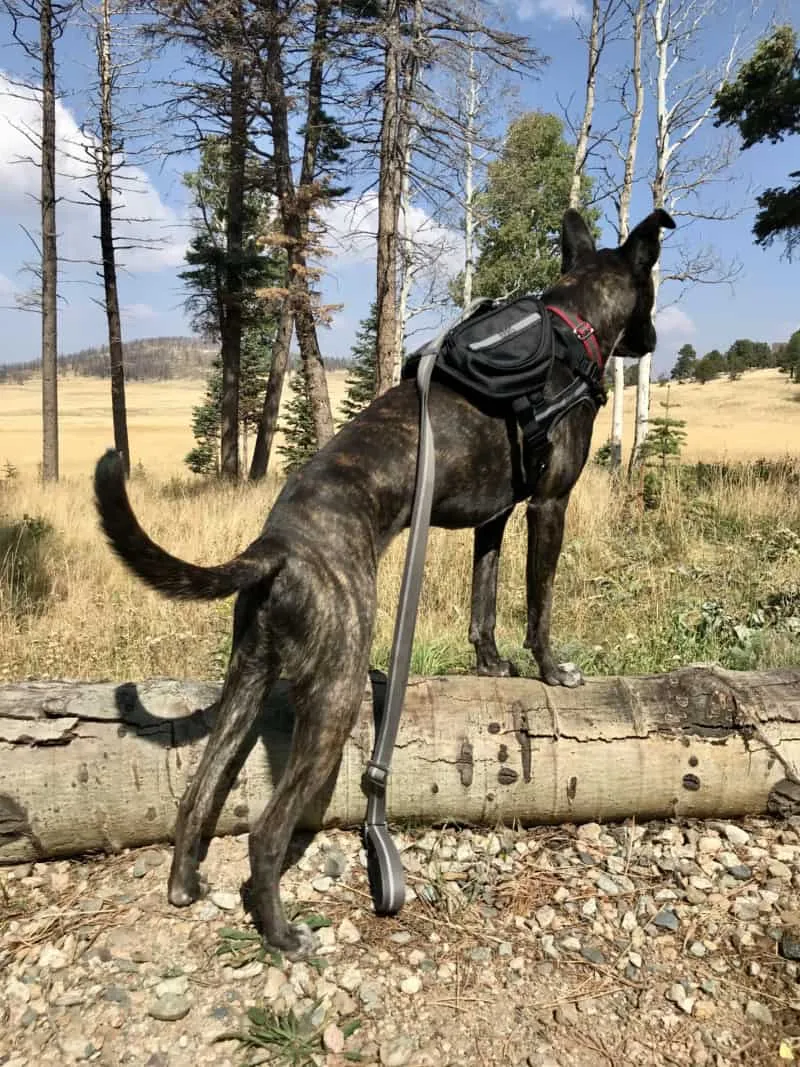 Myles the brindle dog wearing a Sleepypod Clickit Terrain Harness with the optional Terrain Pack, ready for adventures in the UK
Myles the brindle dog wearing a Sleepypod Clickit Terrain Harness with the optional Terrain Pack, ready for adventures in the UK
Other High-Quality Dog Car Seat Belts
AllSafe Comfort Harness
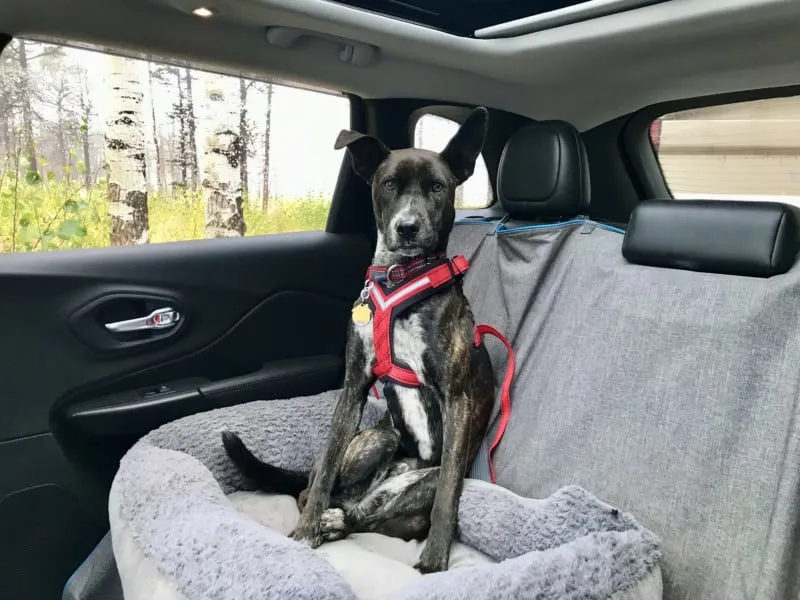 Brindle dog, Myles, buckled up in an AllSafe Comfort crash-tested dog harness, suitable for UK drivers
Brindle dog, Myles, buckled up in an AllSafe Comfort crash-tested dog harness, suitable for UK drivers
Highlights
- Crash Tested: Tested in Germany according to ECE R-17 and ISO27955, recognised European safety standards.
- Sizes Available: S to XL.
- Girth Capacity: 6.4 to 12 inches (approx. 16.3 cm to 30.5 cm).
- Installation: Involves attaching screw locks and two clasps to the vehicle’s seat belt, then using a swivel snap to connect a tether to the harness.
The AllSafe Comfort harness was developed by a German company with 18 years of expertise in designing crash-tested pet safety harnesses. It has undergone rigorous crash-testing in Germany according to established safety standards ECE R-17 and ISO27955. Furthermore, it’s stress-tested to withstand a minimum of 4,410 pounds of force for sizes M, L, XL (and 2,205 lbs for size S). Its padded chest and back plates are designed to mould to your dog’s body, ensuring a comfortable yet secure fit.
What We Like:
- Harness features a simple, non-bulky design.
- D-rings on the back allow for convenient leash attachment.
- Constructed from high-strength polyester fabric for exceptional durability.
- Can be spot cleaned or easily washed by hand.
- Includes a seat belt tether with a swivel snap, simplifying the process of connecting the harness to the seat belt.
What We’d Change:
- The installation of the tether is more involved than most harnesses, requiring two clips on the seat belt and threading the seat belt through screw locks.
- The over-the-head design, combined with a single side release buckle, necessitates feeding the dog’s front paw through the harness, which can make it a little trickier to put on and take off.
EzyDog Drive Harness
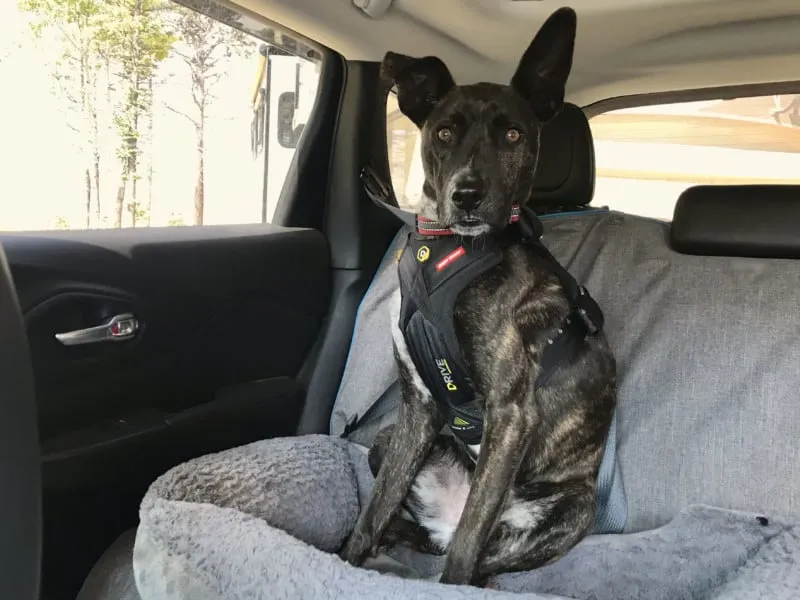 Myles, a brindle dog, in a medium EzyDog Drive crash-tested car safety harness for secure travel in the UK
Myles, a brindle dog, in a medium EzyDog Drive crash-tested car safety harness for secure travel in the UK
Highlights
- Crash Tested: Tested at Automotive Safety Engineering in Australia, a facility recognised by American, European, and Australian child-restraint regulatory agencies.
- Sizes Available: S to L.
- Weight Capacity: 15 to 75 pounds (approx. 6.8 kg to 34 kg).
- Installation: The vehicle’s seat belt passes through two loops on the back of the harness.
The Drive harness by EzyDog is the most structured and substantial among the harnesses we tested, engineered for maximum safety and durability. It has been rigorously crash-tested at Automotive Safety Engineering in Australia, a highly respected facility. This harness features an ergonomic moulded chest plate that adapts to your dog’s shape, straps made from vehicle-tested seat belt webbing, and robust aluminium alloy glides, making it an exceptionally strong choice among dog car seat belts.
What We Like:
- Step-in design ensures easy on and off.
- Double D-rings on the back provide convenient leash attachment.
- Highly durable construction and hand washable for easy cleaning.
- Webbing is clearly marked for balanced measurements on both sides of the harness, aiding in proper fit.
- Hook-and-loop tabs effectively hold excess straps in place.
What We’d Change:
- The sturdy chest plate, while protective, can be less comfortable for very long rides.
- Its bulky nature may not be ideal for smaller dogs.
- The wide chest plate might not be suitable for narrow-chested dog breeds.
Kurgo Impact Harness
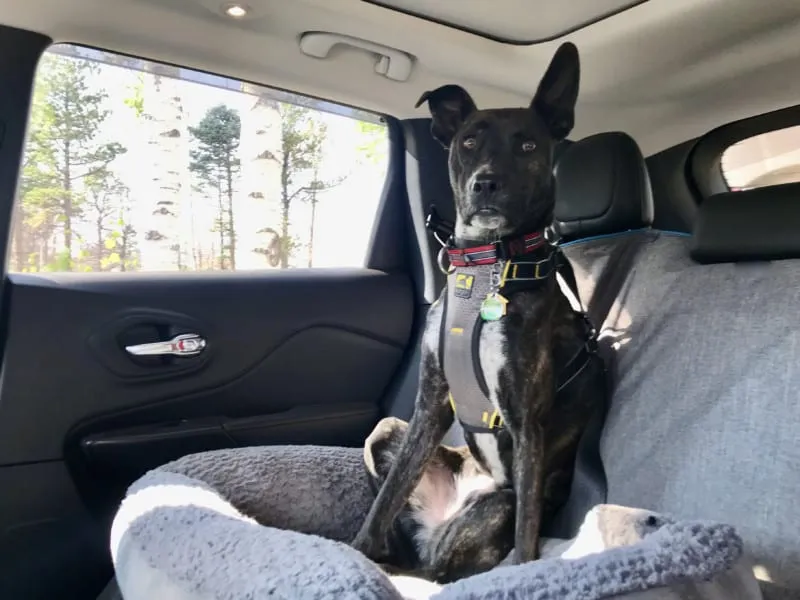 Myles, a brindle dog, safely buckled in a medium Kurgo Impact crash-tested dog car harness, a secure option for UK roads
Myles, a brindle dog, safely buckled in a medium Kurgo Impact crash-tested dog car harness, a secure option for UK roads
Highlights
- Crash Tested: Evaluated at Calspan using current PPSC (Pet Passenger Safety Crashworthiness) testing guidelines.
- Sizes Available: S to XL.
- Weight Capacity: 10 to 108 pounds (approx. 4.5 kg to 49 kg).
- Installation: The vehicle’s seat belt passes through both restraint straps on the back of the harness.
Constructed from heavy-duty 4,000-pound tubular webbing and featuring all-steel buckles and hardware, Kurgo’s Impact harness is built for extreme strength and durability. It underwent comprehensive crash-testing up to 108 pounds at Calspan, an independent engineering and test services company, in 2020. These tests followed the Federal Motor Vehicle Safety Standard for child restraint systems, providing a strong indicator of its protective capabilities. Its robust construction ensures it’s a reliable choice for securing your dog in the car.
What We Like:
- A D-ring on the back offers convenient leash attachment.
- Easy to spot clean or hand wash for maintenance.
What We’d Change:
- The harness is an over-the-head design, and both of the dog’s front legs must be fed through the restraint loops, making it less straightforward to put on and take off.
- The nesting buckles can be difficult for some individuals to operate.
- The webbing tends to slide through the buckles, often requiring frequent readjustment to maintain a secure fit.
- The restraint loops can interfere when the harness is used for walking, making it less ideal as an all-in-one solution.
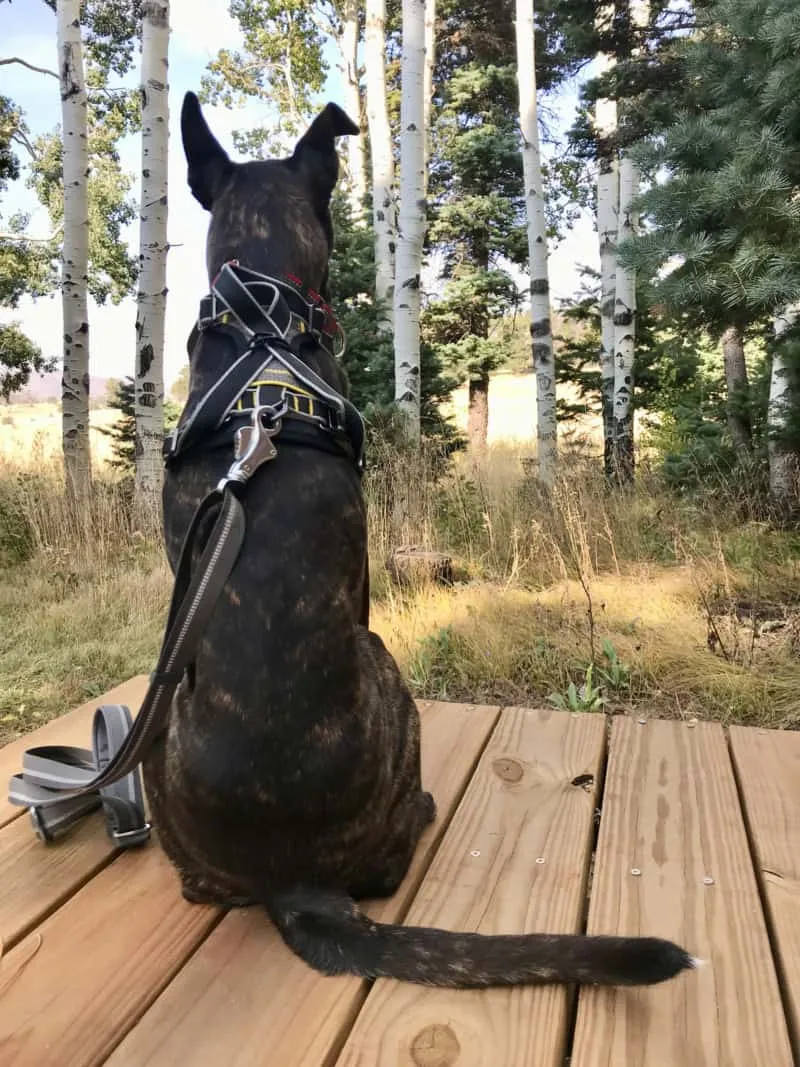 Brindle dog sitting outdoors wearing the Kurgo Impact crash-tested car safety harness
Brindle dog sitting outdoors wearing the Kurgo Impact crash-tested car safety harness
Ensuring the Right Fit and Acclimation for Your Dog’s Car Seat Belt
Choosing the best dog car seat belt UK is just the first step; ensuring it fits perfectly and your dog is comfortable with it is equally crucial. A harness that doesn’t fit correctly won’t provide the intended protection and can even pose a risk if your dog can squirm out while you’re driving.
Achieving the Perfect Fit:
Always consult the manufacturer’s sizing chart and fitting recommendations meticulously. These charts usually provide guidance based on your dog’s chest girth and weight. If your dog falls between sizes, it’s generally advisable to choose the larger size, as this typically allows for more adjustment to tighten the straps for a snug fit. A properly fitted harness should be snug enough that you can only comfortably slide two fingers underneath the straps, without being too tight or restricting movement.
Acclimating Your Dog to Their New Car Seat Belt:
We understand that some dogs might initially dislike the confinement of a car seat belt. However, this is about their safety, and with patience and positive reinforcement, most dogs can learn to accept and even enjoy being secured.
- Introduce it at home: Start by allowing your dog to wear the new car seat belt harness around the house for short periods. This helps them get used to the feel without the added stress of the car.
- Practice buckling in: Once your dog is comfortable wearing it indoors, practice buckling them into the car while it’s stationary. Start with just a minute or two, then release them. Always offer plenty of tasty treats and praise to create a positive association.
- Short, happy drives: Slowly increase the time your pet spends buckled in. When they seem comfortable, try a very short drive around the block. Crucially, ensure these first few trips end in a “happy place” – like the dog park, a favourite walking spot, or a playdate with a furry friend. This reinforces the idea that the car seat belt leads to good experiences.
- Gradual increase: Gradually build up the length of your trips, always observing your dog’s comfort level and continuing with positive reinforcement.
Remember, consistent positive reinforcement makes the training process much easier and more effective. It’s worth the effort to ensure you choose a car harness that makes your dog as comfortable and secure as possible for every journey.
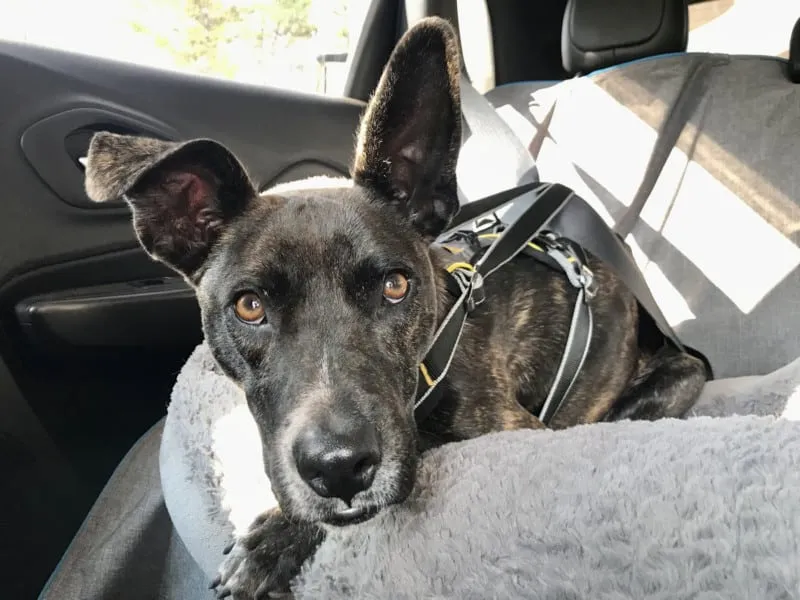 Brindle dog patiently buckled up in a Kurgo Impact crash-tested car seat belt harness, ready for travel in the UK
Brindle dog patiently buckled up in a Kurgo Impact crash-tested car seat belt harness, ready for travel in the UK
Conclusion
Ensuring the safety of our canine companions during car travel is a fundamental responsibility for every dog owner in the UK. From preventing distractions to offering crucial protection in the event of an accident, a reliable dog car seat belt or harness is an indispensable piece of equipment. While the absence of a single, universally adopted UK crash-test standard for pet restraints presents a challenge, opting for products that have undergone rigorous independent testing by reputable bodies provides the highest assurance of safety.
Our extensive review of the best dog car seat belt UK highlights several top-performing harnesses that prioritise both safety and your dog’s comfort. By considering factors such as crash-test credentials, ease of use, durability, and fit, you can make an informed choice that will keep your beloved pet secure on every journey. Remember to always ensure a correct fit and gently acclimate your dog to their new restraint with patience and positive reinforcement. Safe travels to you and your furry co-pilot!
